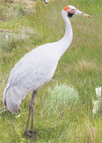 home
homeResources: research
Notes for further research and links to publications:
The text about subjects and issues in an exhibition like this is limited by the constraints of producing a strong visual effect. The text in this exhibition is distilled from wide research into most of the topics that relate to the purpose of the exhibition, which is to expand awareness about the need to conserve what we have left of a unique ecosystem.
There are many books, articles, documents, web sites and other sources to explore and to find out more of the information that will help to understand and help conserve and restore the grasslands, or to simply understand them better, and appreciate their evolution and existence.
We have provided a few of these documents on this website in a form that can be downloaded or referenced by links or other means. The researcher has provided some of the more interesting documents he found about some of the topics that were researched.
All of these have been sourced from various sites and we hope due accreditation for the sources of the documents has been given. If anyone thinks we have not given sufficient accreditation or not given sufficient direction to the home site of any particular document please let us know and we will attempt to redress the situation.
We are aiming simply to widen the distribution of what we see as important articles in the work to save some of the Victorian Volcanic Grasslands.
OVERVIEW
An awareness about the unique nature of the Victorian Volcanic Grasslands and the danger they are in was brought to a head through a milestone conference in October 1992, called
The Great Plains Crash Grasslands Conference
Many of the issues we are still dealing with and a good deal of background knowledge about the grasslands can be found in the papers delivered at this conference, which are all in an archives section of the website of the Indigenous Flora and Fauna Association.
This website also has many other pieces of information about the grasslands and other environments.
http://www.iffa.org.au/
EVOLUTION
One of those articles,
The Biogeography of the Grasses and Lowland Grasslands of South Eastern Australia
by Roger Jones describes the evolution of the grasslands themselves. I found this a very exciting and profound paper after wading through endless pages of Latin names for plants and walking through knee high grass in Deer Park looking for obscure orchids.
http://home.vicnet.net.au/~iffa/GPCconf/Jones1.pdf
A complementary article about the evolution of the grasslands, called
Natural and Human Influences on the Distribution and Extent of Victorian Lowland Grasslands
by Roger Jones can be found on IFFA's website.
http://www.iffa.org.au/IFFA-files/GPCconf/Jones2.pdf
FIRE FARMING
One of the most fascinating and difficult areas to research has been the role of the Aboriginal people in the evolution and management of the landscape. This is an ongoing story and I suspect there is still plenty to discover about this relationship.
Beth Gott of Monash University has been researching plants used by Aboriginal people for many years and her articles are an amazing source of knowledge and inspiration. One of these articles is:
Aboriginal Fire Management in southeastern Australia: aims and frequency,
by Beth Gott and published by the School of Biological Sciences at Monash University.
http://faculty.fortlewis.edu/korb_j/global%20fire/aboriginal%20fire%20management%20australia.pdf
Beth Gott also gave a paper at the Great Plains Crash conference called
Koorie Use and Management of the Plains
http://www.iffa.org.au/IFFA-files/GPCconf/Gott.pdf
For more articles on this subject simply ‘google’ Beth Gott.
WETLANDS
Discovering the role of wetlands in the ecosystems of the grasslands was really fascinating. This could be a life study of its own and it is for some people. We were taken to some very interesting wetlands and were given an introduction into some new research by some very dedicated women who are pioneers in wetland research. Much of their work has been supported by a number of catchment management authorities such as Glenelg Hopkins Catchment Management Authority and Corangamite Catchment Management Authority. For some brilliant work on wetlands see…
Our wetlands, our jewels,
produced by Glenelg Hopkins Catchment Management
http://www.ghcma.vic.gov.au/media/uploads/What%20is%20wetland.pdf
Are there plants in your wetland? Revegetating wetlands,
by Margaret Brock and Michelle Casanova,(2000)
http://freshwater.canberra.edu.au/Publications.nsf/0/88c6dd6d22cb410eca257022002c8ea4?OpenDocument
Are there seeds in your wetland? Assessing wetland vegetation
by Margaret Brock (1997) http://freshwater.canberra.edu.au/Publications.nsf/0/2c644a5a3ad60bfcca257022002cd3b2?OpenDocument
Does your wetland flood and dry? Water regime and wetland plants
by Margaret Brock , Michelle Casanova and Sally Berridge (2000)
http://freshwater.canberra.edu.au/Publications.nsf/0/f6819b2df2679f06ca257022002c0b66?OpenDocument
WOODLANDS
Another significant feature of the Victorian Volcanic Plains are the woodlands that so many early explorers described as being set out like a park in Europe. They had no idea at that time that the landscape was indeed shaped by the hand of man. The CSIRO has produced a book on the woodlands called:
Woodlands a disappearing Landscape that can be ordered on
http://www.publish.csiro.au/pid/4978.htm
Another article on woodlands, called
Temperate woodlands in Victoria: distribution, composition and conservation
can be found on Ian Lunt’s Ecological Research Site:
http://www.csu.edu.au/herbarium/FullText/Lunt%20Bennett%202000%20review.pdf
In fact there is a feast of research material on Ian Lunt’s site and it really is worth a look to find valuable research on a number of related topics.
http://ianluntresearch.wordpress.com/publications-2/
ARCHAEOLOGY
In any research endeavour you come across material you were not even looking for but which turns out to change your way of looking at the world. The following articles about Aboriginal cultivation are in this category. They provide fascinating insights into a world we are still discovering.
The first is called:
Eel Farmers of the Mount Eccles Lava Flow by Heather Builth and can be found at http://www.heritageaustralia.com.au/pdfs/Heritage%200906_Eels%20of%20Mt%20Eccles.pdf
The next is called:
Fishers and Farmers: historicising the Gunditjmara freshwater fishery, western Victoria,
by Ian J McNiven and Damein Bell, published by the La Trobe Journal can be found at … http://nishi.slv.vic.gov.au/latrobejournal/issue/latrobe-85/t1-g-t8.html
Mt Eccles lava flow and the Gunditjmara connection : a landform for all seasons by Heather Builth and can be found at
http://arrow.monash.edu.au/vital/access/%20/manager/Repository/monash:27727
The archaeology and socioeconomy of the Gunditjmara: A landscape analysis from southwest Victoria, Australia by Heather Builth. Go to the bottom of the page where there is a tag to download the whole article as a pdf.
http://www.library.uq.edu.au/ojs/index.php/aa/article/view/6
SHEEP
The story of bringing sheep to Victoria is really quite central to where we are today with regard to the state of the grasslands ecosystem. The introduction of sheep to Victoria transformed the ecosystem faster than most ecosystems have been transformed anywhere in the history of human occupation.
Most of us don’t know things like this. These things have been lost in our own history. The story of sheep is also a central part of our own European story in this part of the world and has made a significant contribution to the lifestyle we have become used to living. However it took me ages to find simple statistics about the numbers of sheep coming in the early years of European settlement. I went to two wool museums without any success.
The best source for basic information turned out to be encyclopaedic books from the 1950’s, when the glory of wool and its role in Australia’s place in the world was really appreciated. Another interesting source of useful information about the history of the sheep industry are newsletters put out by ‘Heritage Sheep Australia’, an organization based in the western district town of Hamilton dedicated to educating people about sheep. One source was this ……
http://www.heritagesheep.org.au/news/92008news.pdf
ORCHIDS
One of the great surprises for me in the research was the great number of orchids out there on those dusty plains. This was a great revelation for someone who did not really have that much knowledge of local indigenous flora, as most people don’t. Despite having worked with environmentalists for years, I knew there were flowers but was not too aware of the orchids. This revelation was very important for me. I thought if more people knew that rare orchids were at risk there might be more interest in the fate of the grasslands.
Environmentalists seem to focus on the grass of the grasslands, which makes perfect sense as the grass is the most significant feature of the plains and everything revolves around the grass. However for me the idea of orchids out there was very exciting. I think more people need to know about them. Again there are a number of dedicated people who have been observing, studying, conserving and generally spending most of their spare time working in some way to save and support these beautiful residents of the Volcanic Plains. I want to know a lot more about the orchids. There is a remarkable story about the efforts to save one particular orchid, the Sunshine Diuris. It is called ‘NATIONAL RECOVERY PLAN FOR THE SUNSHINE DIURIS Diuris fragrantissima’ see
http://www.environment.gov.au/biodiversity/threatened/publications/recovery/d-fragrantissima/pubs/d-fragrantissima.pdf
Probably one of the best places to find out about orchids of the Victorian Volcanic Plains is the Geelong Group of the Austrlasian Native Orchid Society at
http://www.anosvic.org.au/ANOS_Geelong_Bulletin.html
OLD BOOKS & ARTICLES
Sometimes the best source of information and certainly of feeling for information or ambience of a certain time is to be found in old books and articles.
For example there was a journalist named Donald Alaster McDonald, who wrote features for the Argus newspaper in the 1880’s. Some of these articles describe the Keilor Plains at the time and give some good insights and factual information that cannot be found anywhere else. Oddly enough a collection of these articles, which are put together in a book called ‘Gum boughs and wattle bloom, gathered on Australian hills and plains", is held in the archives of the Californian Library in Los Angeles, USA. The whole book of more than 200 pages can be downloaded for free and makes a great read. See
http://archive.org/details/gumboughswattleb00macd
FLORA SPECIES
One of the most difficult challenges in the research for this project was trying to get a grip on the extent of numbers, variety and groupings of the species of flora out there on the Victorian Volcanic Plains. Coming at this without any real previous grounding was quite terrifying. I had to know what was going on with the vegetation classes while on the other hand there was far too much detail to describe in the limitations of any exhibition. Many people have done years of research identifying species and classes and so on that to get a grip on this can take a long time. We didn’t have a long time. There is an endless amount of material on various Department of Sustainability and Environment web pages and archives. The most useful thing I found was a simple classification of plants into families produced by DSE in 2004, called ‘Native Flora VVP Region by Family Groups’ – which you can download from this site, courtesy of DSE.
http://www.dse.vic.gov.au/land-management/land/native-vegetation-home/native-vegetation-information
FLORA & FAUNA GUARANTEE ACT 1988
It was also important to get an understanding of the legal situation with the environmental issues of the grasslands. The State and Federal legislation is an interesting guide to the steps that have been taken in the past to try and conserve what we have left.
http://www.austlii.edu.au/au/legis/vic/consol_act/fafga1988205/
http://www.dse.vic.gov.au/plants-and-animals/native-plants-and-animals/threatened-species-and-communities/listed-items
and
ENVIRONMENT PROTECTION AND BIODIVERSITY CONSERVATION ACT 1999 http://www.austlii.edu.au/au/legis/cth/consol_act/epabca1999588/ http://www.environment.gov.au/epbc/index.html
TAKING ACTION
There are many groups across the plains doing lots or work to rescue, conserve and regenerate these treasures most of us didn’t know we had. A bit of a search on ‘google’ should find you a group nearby that can answer more questions or direct you to more specific places. Meanwhile I also came across another publication from DSE to help those who wanted to do more to help conserve the original ecosystems of this place, called ‘
How To Plan Wildlife Landscapes’
http://www.dse.vic.gov.au/conservation-and-environment/biodiversity/rural-landscapes/biodiversity-and-agriculture/living-systems-home/living-systems-how-to-plan-wildlife-landscapes
TO BE CONTINUED…
Well these are just a few leads for some background on the issues to do with the preservation of something of this devastated landscape. This is mainly information for background education or for giving some sense of time and context. For more practical endeavours you will need to find local ‘Friends’ groups or your local ‘Landcare’ group. There are a lot of people working where they can to try and keep something of this natural heritage preserved. If these links are a help let us know and we will add to them.
Peter Haffenden
Researcher
Inherit Earth
admin@inheritearth.com.au
Some of the
Volcanic Plains'
threatened species...
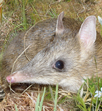
Eastern Barred Bandicoot (critically endangered)

Sunshine Diuris (orchid)
(endangered)*
*'endangered' is the DSE rating for the most threatened flora species
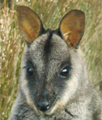
Brush-tailed Rock Wallaby
(critically endangered)
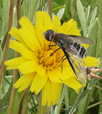
Myrnong Yam Daisy
(vulnerable)

Small Golden Moths Orchid
(endangered)

Bush Stone Curlew
(endangered)
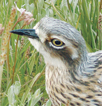
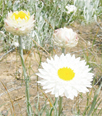
Hoary Sun-ray
(endangered)
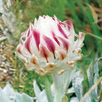
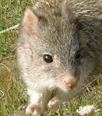
Rufous Bettong
(regionally extinct)
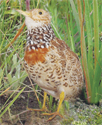
Plains Wanderer
(critically endangered)

Brush-tailed Phascogale
(vulnerable)
Photograph Trevor Pescott

Freckled Duck
(endangered)
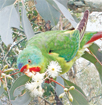
Swift Parrot
(endangered)
Photograph Chris Tzaros

Golden Sun Moth
(critically endangered)
Photograph Reto Zollinger
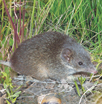
Swamp Antechinus
(threatened)
Photograph Trevor Pescott
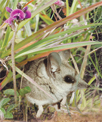
Fat-tailed Dunnart
(threatened)
Photograph Trevor Pescott
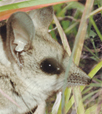

Clover Glycine
(vulnerable)
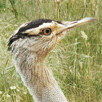
Australian Bustard (female)
(critically endangered)
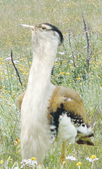
Australian Bustard (male)
(critically endangered)

Striped Legless Lizard
(endangered)

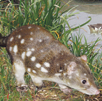
Spot-tailed Quoll
(endangered)
Photograph Trevor Pescott
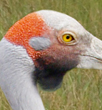
Brolga
(vulnerable)
